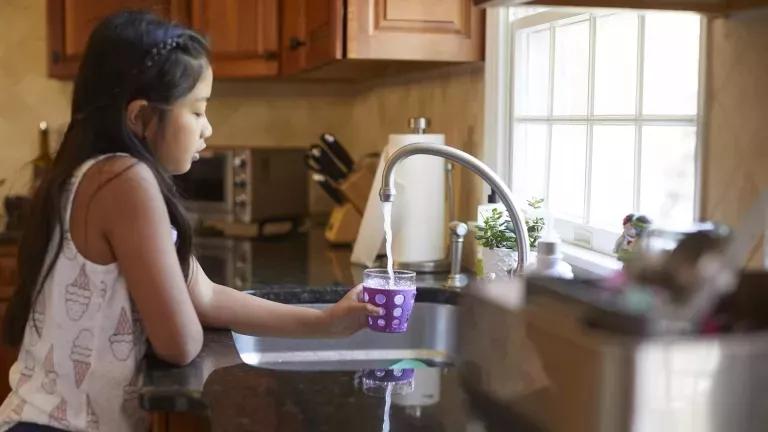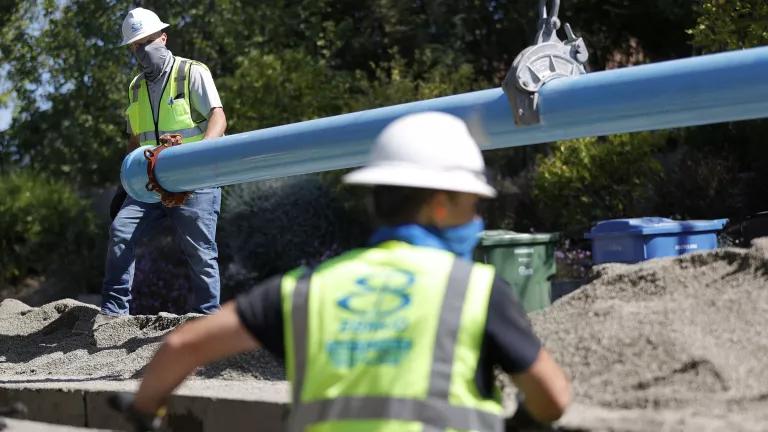What to Look for in a New Lead and Copper Rule
What's needed to fix the EPA's broken rule for lead in drinking water? Some answers here.

Brian Maranan Pineda for NRDC
The U.S. Environmental Protection Agency (EPA) lead in drinking water rule urgently needs an overhaul. The former head of the EPA’s enforcement office called the implementation of this rule “completely broken” and said it’s all but unenforceable. We agree. The EPA has promised to propose a stronger new lead in drinking water rule by this month (November 2023). We thought it would be worth briefly highlighting some of the most important improvements to look out for in the upcoming new Lead and Copper Rule proposal.
One of the biggest problems with the current rule is that it fails to cap the allowable level of lead in tap water. So, the first question is, will the EPA set a directly enforceable limit (called a Maximum Contaminant Level or MCL) for lead? We and our allies have called for an MCL of 5 parts per billion (ppb) at the tap. Canada recently set a maximum lead concentration of 5 ppb, and the EU recently recommended that its maximum lead level in drinking water be dropped from 10 ppb to 5 ppb.
But if the EPA finds it’s infeasible to set an MCL and instead sticks with a “treatment technique,” some of the key questions are whether the new proposal will include:
- A requirement that 100 percent of the lead service lines in the country be fully replaced, allowing no longer than 10 years to complete the job. President Joe Biden, Vice President Kamala Harris, and EPA Administrator Michael Regan have repeatedly stated this goal.
- A requirement that water systems fund the full cost of replacement of lead pipes under both public and private property. This is crucial, since low-income homeowners often cannot pay for lead service line replacement and landlords often refuse to do so, creating a major environmental injustice. It also has been shown repeatedly that only when the utility picks up the full tab can service lines be quickly and efficiently replaced, entire streets at a time, which significantly speeds up replacement and lowers costs.
- A ban on partial lead service line replacements. These partial replacements can increase lead levels at the tap for some time and don’t solve the lead problem.
- A requirement for a full inventory of all service lines, including verification requirements, to identify all lead and galvanized pipe service lines.
- Clear sampling protocols to fully capture lead levels in tap water, including testing first-draw and fifth-liter water, and a ban on methods that minimize detections of lead.
- Robust monitoring of vulnerable homes, based on mandatory targeted monitoring of identified high-risk homes and more frequent sampling at the tap.
- Requirements for prompt, accurate, effective, and understandable public notification that can effectively reach diverse audiences.
- A reduced action level for lead of 5 ppb. The current 15 ppb action level is extraordinarily unprotective and must be reduced.
- Strengthened requirements for corrosion control. While removing lead service lines will make a major dent in the problem, many homes have lead-containing indoor plumbing (such as lead pipes, lead solder, or faucets containing some lead). Corrosion control helps reduce lead levels from both indoor plumbing and lead service lines while they’re still in use.
- Mandatory electronic reporting of test results and violations. The former EPA head of enforcement has highlighted this as an urgent need, emphasizing that without it, rampant violations (often unreported to the EPA) will continue.
- A requirement for utilities to comprehensively test for lead from all fountains and drinking water sources at schools and day care centers, and provisions that create strong incentives for utilities to help schools install filtration stations.
- Guidelines to help water systems adopt affordability programs to avoid exacerbating problems of water affordability for low-income consumers. The guidelines should draw on the February 2023 Clean Water Act Financial Capability Assessment Guidance, including helping utilities seek all available government and other funding and encouraging water systems to adopt water affordability programs and equitable water rate designs, many of which are outlined in the NRDC and National Consumer Law Center’s Water Affordability Advocacy Tool Kit.
There are many other key improvements needed in the EPA’s lead in drinking water rule, but if the agency makes these changes, they will go a long way toward improving the health of millions of Americans (for more detail on some of these issues, see my earlier blog). We also will be keeping an eye out for whether the agency considers the full array of health and economic benefits that would result from reducing lead in water, including fewer cases of cardiovascular disease and deaths. A thorough assessment of these benefits will show that strengthening of the agency’s lead in drinking water rule provides benefits that exceed costs by an order of magnitude or more, as is demonstrated in our recent study and the Harvard T.H. Chan School of Public Health researchers’ published paper, upon which our study is based.
The $15 billion in funding to help remove lead service lines in President Biden’s Bipartisan Infrastructure Law will be a big help. But without mandatory requirements in this drinking water rule, history shows us that many water utilities will not take meaningful action to reduce their lead levels. We can fix the lead in drinking water problem. The EPA just needs to muster the will and carry out its legal responsibility to make it happen.
Millions of Americans drink tap water served by toxic lead pipes.
Tell the EPA we need safe drinking water!

Tell the EPA we need safe drinking water!
There is no safe level of lead exposure. But millions of old lead pipes contaminate drinking water in homes in every state across the country. We need the EPA to do its part to replace lead pipes equitably and quickly.







